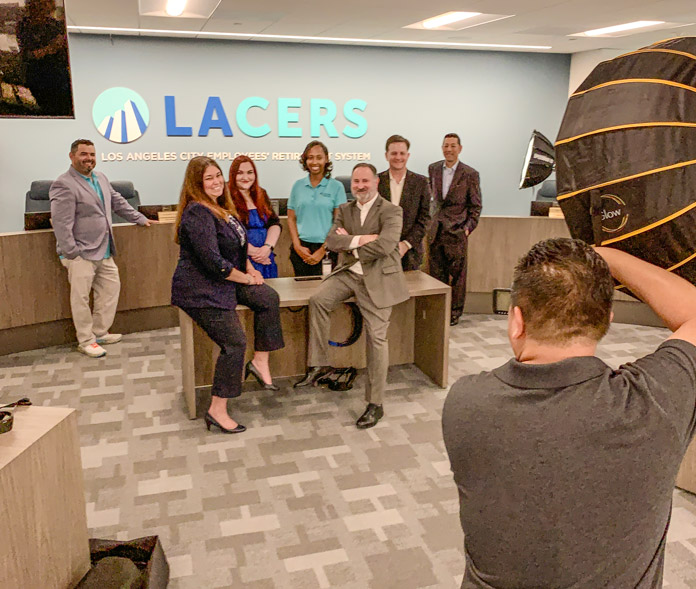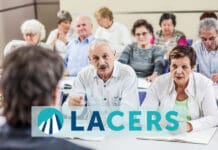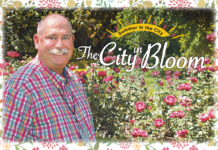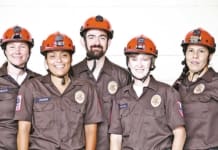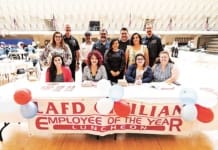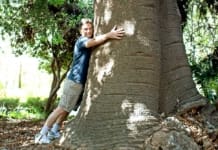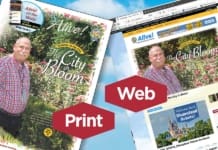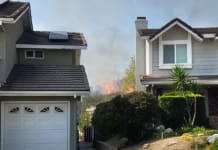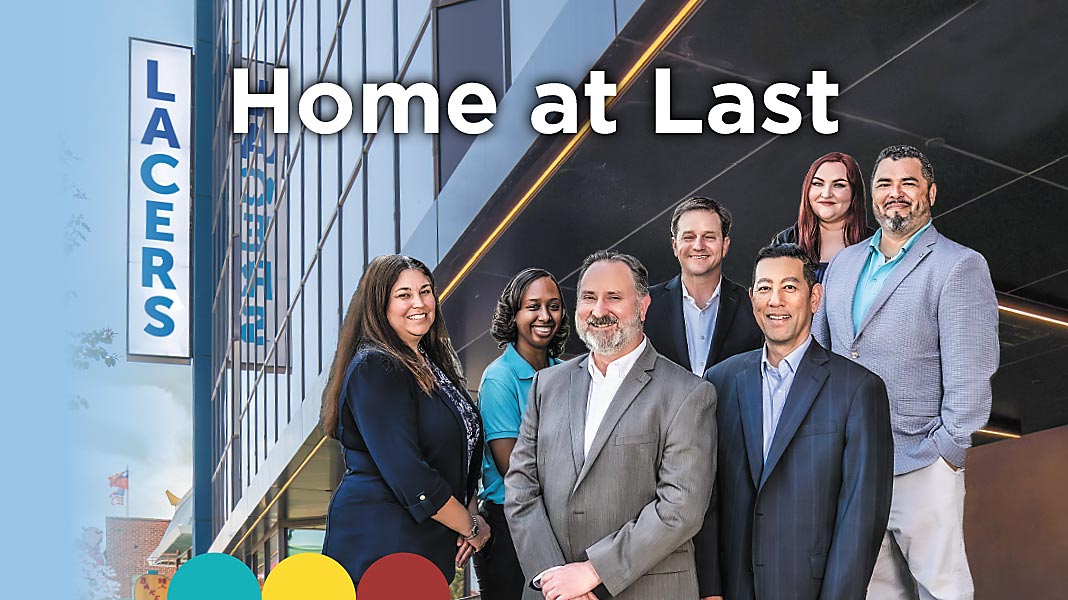
Photos by Summy Lam, Club COO
I
t’s been a long time coming. But now it could spell the future for very long time.
At long last, the Los Angeles City Employees’ Retirement System – one of three City pension manager departments – has found a home. The new LACERS headquarters on the edge of Chinatown looks to do things differently, including wellness initiatives, technology, remote work readiness, emergency preparedness and collaboration.
But mostly it’s about customer service for all City employees who are nearing retirement, and those already retired. The headquarters building is the central spot for the next chapter of your life, and the building and staff are ready for you.
Read all about the new LACERS headquarters, including an interview with the core team that contributed to its design and management, in this month’s feature.
The Club thanks Heather Ramirez, LACERS Sr. Benefits Analyst II and longtime liaison between the department and the Club, for her assistance in coordinating this story.

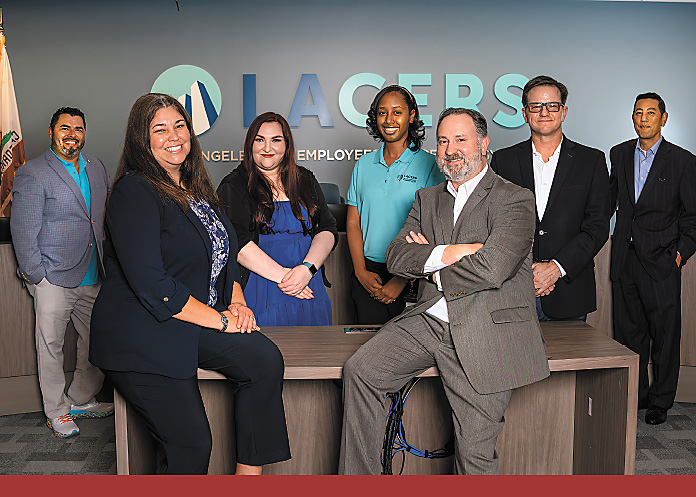
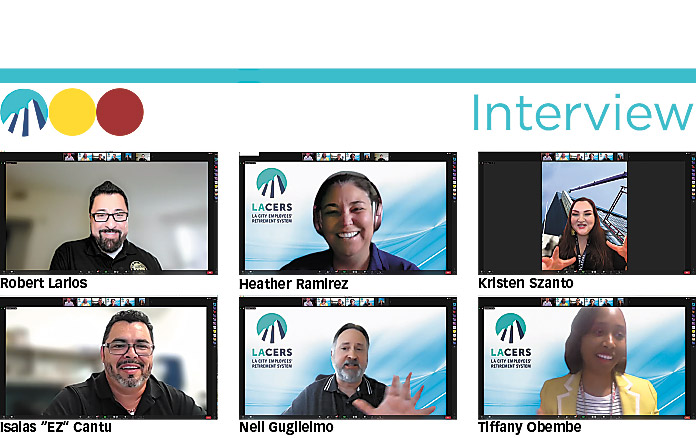
The Future of City Buildings
On April 20, Club CEO Robert Larios and Alive! editor John Burnes interviewed the team behind managing the design and opening of Los Angeles City Employees’ Retirement System’s (LACERS’) new headquarters building in Chinatown. The team includes: Neil Guglielmo, General Manager, 33 years of City service; Isaias “EZ” Cantu, Sr. Management Analyst II, 21 years; Kristen Szanto, Management Analyst, 4 years; Heather Ramirez, Sr. Benefits Analyst II, 16 years; and Tiffany Obembe, Sr. Benefits Analyst I, 8 years. All are Club Members. Neil served as a Club Board Member.
Thanks for joining us today to talk to Alive! about your new headquarters.
Isaias “EZ” Cantu: Consider me a fan. I read Alive! every month, I go through it, look at the content, and then I take a look at who’s retiring. I think, did we serve them well? I hope so.
I’m sure you did. We’ve been talking with Heather for months now about doing a story on your new headquarters. We’re glad it’s finally opening!
Heather Ramirez: We just opened it a few weeks ago. This is perfect timing.
Great. First question: How did you get to your current position? What was your journey? Let’s start with Neil. We’ve known you a long time, Neil, as you were on our board. Has it been a decade?
Neil Guglielmo: I think that is pretty close, yes.
I started with the City when I was just graduating high school, working for Rec and Parks as a part-timer. I was an Assistant Park Services Attendant II, and I loved my job. I went to college and graduated, worked in the private sector briefly for one year, and then I was able to take a position as a Management Assistant with the Dept. of Aging. Since then I’ve worked in nine departments in 33 years. I’ve done lots of different kinds of work. I’ve loved every minute of it, but I’m loving LACERS the most.
Great. Excellent. Okay, EZ.
Isaias “EZ”: I’ve worked at many different City departments, including City Clerk, Airports, Finance, Controllers’ Office and Personnel; those are the ones I can remember. Generally I’ve worked on implementing large-scale projects, including their evaluation, development, incorporation of efficiencies and technology to streamline projects. I’ve been with LACERS for the last five years, and it’s head and shoulders above all other departments I’ve worked for. I love LACERS and the team here.
Kristen Szanto: I came to the City after 15 years of project management and visual design in the private sector. I started in the film industry at Paramount Pictures, and then I jumped into design. I worked with clients like Best Buy, Epson, Nutribullet and Discovery Channel, among others. And then I stumbled into my City career like most people – I met someone who worked in the City. When we were comparing war stories, his were never as bad as mine, no matter how he tried. It made us laugh. I remember saying to him, “Even with your worst example, at the end of the day, you go home knowing you have a greater purpose and that you served the community.” I was just making a rich person richer. Once I said that out loud I couldn’t shake it. It took me about a year to finally say, yes, I needed to join the City. I took a pay cut, and I started from the bottom. Now here I am, and it’s the best decision I’ve ever made. I love it here.
What a great story. Tiffany?
Tiffany Obembe: My background is in broadcast journalism, and I never thought I’d work for the City. Both my parents were City employees, and it wasn’t my thing. But lo and behold, out of college I needed a job, and I started off as a Relief Retirement Worker here at LACERS, and I quickly became invaluable. But then my part-time hours ran out, and I had to leave. I worked at a couple other agencies for a while, but eventually I landed back with the City. I’ve worked for only two departments with the City – Personnel Employee Benefits for a little while, before LACERS picked me up as an Administrative Clerk. Since then I’ve been at LACERS making my way to where I am now over the Member Engagement team. I like where I am, and I wouldn’t have it any other way.
You mentioned your parents. In which City departments were they?
Tiffany: My dad worked for Public Works/Sanitation, and my mom worked for the Office of Finance. She did business tax licenses. I’m City born and raised.
Finally, Heather.
Heather: I was fresh out of college working at Disneyland, and my dad played basketball on Saturdays with someone who worked with the LADWP. He told my dad, “Why doesn’t your daughter take an exam for the City?” My dad came home with the information and I signed up to take the Clerk Typist exam. About six months later I got a job at Airports/Human Resources. I worked up to Personnel Analyst there, and stayed there for about seven years. I’ve been at LACERS since 2014.
Long Journey Home By Tom Moutes, RLACEI Director EDITOR’S NOTE As LACERS moves into its new building at 977 N. Broadway, here is a retrospective of LACERS’ various head-quarters buildings. Decades ago, LACERS was housed in City Hall South. The City, needing more office space, asked LACERS to move out. I’m not sure if LACERS had any other headquarters before moving to the Brunswick Building at 360 E. Second St., but it was located at that address for decades.
When LACERS took the Times lease proposal to its Board for approval, the City Administrative Officer (CAO) made an impassioned plea to our Board to not adopt the staff recommendation, but instead become partners in the new building the City was planning to build at the old Parker Center site. Ultimately, the LACERS Board agreed to the lease at the Times complex, which was a good thing as that was many years ago and the new City building was never built! The City was interested in having its pension funds pay for the building. I was LACERS’ General Manager at the time; I told the City that the only way we could have that conversation was if the City would agree to long-term leases at market rates. That was the last I heard of that proposal! LACERS was the first outside entity to lease space at the Times complex, and it was an improvement over the Brunswig Building. However, LACERS continued to look for a permanent location, including the possibility of purchasing a skyscraper in the downtown area and leasing most of the building to other tenants. Fairly recently, LACERS purchased and renovated the building at 977 N. Broadway. While I’m sure there will be some limitations to the new headquarters, as there were with all of the buildings and sites LACERS considered over the years, I’m sure there will be some great features, too. It is great to see LACERS finally have its own building, and I look forward to visiting it soon! It has been a long journey to get to this point. • |
 The New HQ
The New HQ
First, in general terms, describe your exciting new headquarters building.
Isaias “EZ”: This has been a three-year project, a labor of love. We’ve loved every minute of every day working on this project. 977 N. Broadway was built in 1983. It’s a five-story building totaling 64,000 square feet of office space, with a 120-space subterranean parking structure. LACERS bought the building in October 2019 as a parent home for LACERS to provide Member services, the Board a place to meet, and then for staff to have a space to perform their work.
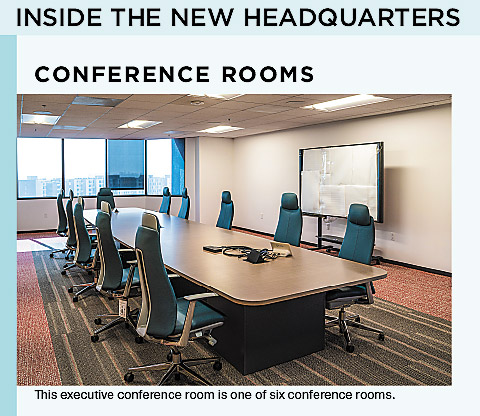 The building has 253 workstations, including 64 private offices and 189 cubicles, all including ergonomic furniture, sit/stand desks for all, and hardware and equipment that are ergonomic and promote wellness for our staff. The building has a boardroom; an emergency operations center in case of emergencies for business continuity; a training multi-purpose room; six conference rooms; five collaboration spaces; four counseling rooms; and a green wellness terrace. The building is fairly close to Union Station and also contains bicycle parking, so we can accommodate trains, automobiles and bikes – take whatever you want to get here. And last but not least, we also continue the work of designing the building for the future by preparing a 10-year capital plan for improvements. We want to make sure we incorporate eco-friendly and sustainable practices now and in the future.
The building has 253 workstations, including 64 private offices and 189 cubicles, all including ergonomic furniture, sit/stand desks for all, and hardware and equipment that are ergonomic and promote wellness for our staff. The building has a boardroom; an emergency operations center in case of emergencies for business continuity; a training multi-purpose room; six conference rooms; five collaboration spaces; four counseling rooms; and a green wellness terrace. The building is fairly close to Union Station and also contains bicycle parking, so we can accommodate trains, automobiles and bikes – take whatever you want to get here. And last but not least, we also continue the work of designing the building for the future by preparing a 10-year capital plan for improvements. We want to make sure we incorporate eco-friendly and sustainable practices now and in the future.
Kristen: 977 N. Broadway is a very distinctive-looking building. It’s a blue cube that complements the beautiful array of colors in old Chinatown. The building itself is stunning. It’s a mid-rise, a tiny skyscraper. It’s meant to be a permanent home to serve the lifelong needs of our members – City employees, Retirees and their loved ones. And it’s also intended to stop draining administrative funds from leasing commercial space near City Hall, since market rates are heading toward a million dollars a year for a department our size and would only continue to rise; that’s money you don’t get back when you lease. Everything that we put into the initial purchase of the building is still preserved in its current value, which we know has already increased since we purchased it.
Tiffany: In the simplest terms, it’s a place for my team. In the old building we didn’t have a place where all of us could be in the same area; we were spread out just because of spacing issues. Here, all of us can meet literally in the same area and be able to see each other and interact. We can feel that team mentality. It gives us a bonding area where we can get together and complete our everyday tasks and work, and it just feels more comfortable. I am definitely a big supporter and a fan of the work EZ and Kristen did, and how everything came together.
Heather: I oversee the team that has first contact with the members – our Member Service Center team, and the work that EZ and Kristen did to make that space on the first floor where members meet our staff, is beautiful. It looks amazing. Our presentation to our members is pretty awesome now, and I’m very excited for our members to see it for their first time.
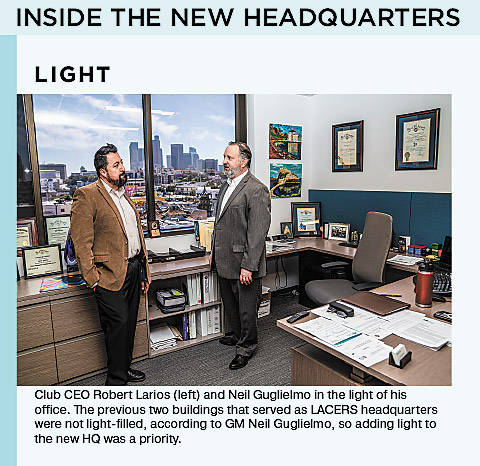 Neil: The lease space we were in at the former LA Times property was I think a 10-year lease. We had negotiated good lease rates, below market. But the building was very old, and we were lacking a number of things. The vast majority of the staff was located in the central core of one of the buildings where there was no access to natural light, so you had to actually leave the offices to get access to natural light. And there wasn’t a great place for staff to get together – we had a relatively small board meeting room and some limited conference space, but we didn’t have great staff training or education space. There was no collaboration space. The previous headquarters lacked a number of things.
Neil: The lease space we were in at the former LA Times property was I think a 10-year lease. We had negotiated good lease rates, below market. But the building was very old, and we were lacking a number of things. The vast majority of the staff was located in the central core of one of the buildings where there was no access to natural light, so you had to actually leave the offices to get access to natural light. And there wasn’t a great place for staff to get together – we had a relatively small board meeting room and some limited conference space, but we didn’t have great staff training or education space. There was no collaboration space. The previous headquarters lacked a number of things.
The lease was going to be up, and the building ownership had gone through the process already to approach the City about demolishing the building and the adjacent parking structure. Their plans are to build some large towers there, so there was no long-term perspective for that property for us anyway. And as Kristen mentioned, when you’re paying a lease you’re not building equity in anything. You don’t have any ownership rights, and you don’t have control over the property. And so for us it was important to own a building and not have to constantly move from lease space to lease space because we serve a lot of active and Retired members. We don’t want them to worry where we’re going to be in two years. So now members will know where we are.
 Our building has all these great elements to it. But when you go inside the building, that’s when the magic happens. When you go inside and go to each floor, you see that the offices are on the interior, and all the staff cubicles are by the windows. That means everybody has access to natural light.
Our building has all these great elements to it. But when you go inside the building, that’s when the magic happens. When you go inside and go to each floor, you see that the offices are on the interior, and all the staff cubicles are by the windows. That means everybody has access to natural light.
The health and safety aspect of the building is top-notch. We survived the pandemic, and who knows if there are going to be more pandemics in the future. But we looked at all the design elements so that we have a lot of touchless services. We have great cubicles that have a kind of Plexiglas that provides still more natural light coming in, but dampens the noise. Everything is ergonomic. We have sit/stand desks for everyone and ergonomic chairs, and everything was designed to be as user-friendly as possible. I couldn’t be happier, and I’m happy for the staff because they finally got the space that they deserve.
Members are already visiting, right? You’re already open.
Heather: Yes, they are. We are open Monday through Friday from 7 a.m. to 4 p.m. for our members, and we’ve seen a nice bunch of people coming to visit us in the first few weeks that we’ve been open to them. We opened April 3.
Excellent. Did the building need to be retrofitted?
Neil: Yes. We strengthened the structure. It can withstand a pretty sizable earthquake, and we live in earthquake country in LA.
Kristen: We even took the opportunity to weld additional steel to the elevator shafts, which is very difficult to do in general, and almost impossible in an occupied building, so we’ve taken care in making the building safe for decades.
Isaias “EZ”: It has an emergency operations center and an emergency generator.
Neil: We are good to go to serve our members, no matter what happens.
Was the board involved?
Neil: Definitely. An ad hoc committee of the board met regularly to discuss various aspects of the search for a building. We had talked about leasing versus procuring the building, the benefits of each. Some financial analysis had been done by one of our real estate consultants as well to assist with the math, and ultimately the decision was made by the board. Staff made recommendations, and in October 2019 the board approved it, and we signed off and purchased the building.
 Certifications and Designs
Certifications and Designs
Speaking of retrofitting, I presume it meets all modern certifications for renovations.
Isaias “EZ”: LA’s building code incorporates LEED requirements as the minimum benchmark. The building meets all LEED certification levels. Although we’re not formally certified, it does meet all of the levels. Additionally, we are Fitwel certified.
Fitwel is a healthy building certification system.
Kristen: Yes. Fitwel is like LEED certification, but more. It’s a program that’s also about employee wellness. We had to go through a rigorous amount of things to make this happen, but we earned two out of the three stars possible. Some of the innovations include the ergonomic furniture we’ve been talking about, and details like beautifully painting the stairways to encourage walking. It’s a lot more than updating fixtures to energy efficient ones like with LEED. Fitwel gets into things like indoor air quality policies, walkability of the neighborhood, and even the design of the pest control program, encouraging integrated solutions that minimize staff exposure to harmful insecticides. Every piece of this building is motivated to improve the wellness and wellbeing of staff.
Our building was built in 1983, so it was often a challenge to incorporate Fitwel standards, but we did it.
Neil: One thing that was neat was having our architectural design firm work with the staff to come up with color palettes and textures, to bring this space alive. So many buildings have white walls and a gray floor; it’s boring and doesn’t speak to its inhabitants at all. There’s color here, and the color ties to each of the different work units and divisions we have. It flows in a cool, creative way.

 Location, Location
Location, Location
What’s special about the location?
Neil: We’re a great anchor at the end of Chinatown, a beautiful location. We share a wall with Phoenix Bakery. It doesn’t get much better than that. Staff can walk very short distances to great restaurants. With all the culture, shopping and people, it’s a great feel. And we’re helping revitalize that end of Chinatown as well. And we can look northwest and see Dodger Stadium, and that’s inspirational – who doesn’t love the Dodgers!
Isaias “EZ”: It’s a cliché, but location, location, location. The building is smack dab in LA’s vibrant Chinatown. It’s a stone’s throw away from the Civic Center, which makes it convenient for meeting with the City departments and City Hall. It’s also close to Union Station, and along many commuting vines that staff and members use to come to the office. And the view of the LA skyline from the roof and from many windows inside the building is breathtaking. Seeing it for the first time sealed it for me. I didn’t have a vote, but if I had a vote, I sure as heck would have chosen this as our new home.
Kristen: The view of City Hall is stunning. The colors from our angle are unlike any view I’ve ever seen of the LA skyline, with the candy-colored pinks and the yellows, terra cottas, the pastel skyscrapers. When you see the view you know instantly why LACERS pulled the trigger on this building. It’s inspiring to see the community we serve.
Heather: Our team was the first to move here in February 2020. Just being the first group over here, seeing the freshness of the building and seeing how different and how much more modern it is than our previous location, it put a smile on my face; it was just amazing.
Tiffany: Moving in here made me feel like a cool hipster. It’s unlike any City office that I have ever seen.
 Tech and Fresh
Tech and Fresh
What does the new HQ allow LACERS to do that’s innovative?
 Tiffany: LACERS is transitioning into a new age of adopting technology. Before the pandemic, we switched over to laptops instead of desktops, and to using more remote-type technology. I looked forward to coming back from the pandemic into this new space that I knew would be modern, pretty and aesthetically pleasing.
Tiffany: LACERS is transitioning into a new age of adopting technology. Before the pandemic, we switched over to laptops instead of desktops, and to using more remote-type technology. I looked forward to coming back from the pandemic into this new space that I knew would be modern, pretty and aesthetically pleasing.
We have video screens on every floor, and we… can program them. For Women’s History Month we had a guest speaker from the LA Civil and Human Rights Dept. We advertised her visit with a photo and bio on those screens. And I made a video about Women’s History Month honoring LACERS staff past and present, so it could play and everyone could watch in the kitchenettes on each floor. We plan to use that more and more for outreach and education to staff.
Heather: We programmed the video screen on the first floor to provide information to our members when they come to visit.
Neil: The amount of IT infrastructure installed into the building, it’s night and day compared to what we had access to at the old property when we were leasing space. Our IT team worked with consultants to actually design a huge IT room with multiple redundancies. It looks like you’re going into NORAD. It’s going to be good for … the next 20 years.
Isaias “EZ”: There are two things that this building does that are fresh – one is incorporating wellness, and the second is incorporating technology to support productivity. The building provides the tools to enable staff to be productive. It’s not just forcing people to work, work, work, it’s supporting that work, that productivity.
 In terms of wellness, again, we invested in employee wellness in Fitwel. We want to increase happiness, productivity and staff retention, because that’s critical for every organization. Our design emphasizes the ability to support and retain that staff. We incorporated a staff meditation terrace in the design where staff can go outside and sit, eat and work because of the technology that we’ve incorporated. Our new technology allows staff to contribute and be productive anywhere in the building. They’re not chained to their desk, they can go somewhere where they can breathe. They can pick up their laptop and work on the terrace, in a lounge area, or in a collaboration area. Employees decide where they want to be productive and how they want to contribute. That is a new concept we’ve incorporated in the whole building. That is a testament to all of the work that our system staff did to rethink how we will accomplish our work here at the headquarters.
In terms of wellness, again, we invested in employee wellness in Fitwel. We want to increase happiness, productivity and staff retention, because that’s critical for every organization. Our design emphasizes the ability to support and retain that staff. We incorporated a staff meditation terrace in the design where staff can go outside and sit, eat and work because of the technology that we’ve incorporated. Our new technology allows staff to contribute and be productive anywhere in the building. They’re not chained to their desk, they can go somewhere where they can breathe. They can pick up their laptop and work on the terrace, in a lounge area, or in a collaboration area. Employees decide where they want to be productive and how they want to contribute. That is a new concept we’ve incorporated in the whole building. That is a testament to all of the work that our system staff did to rethink how we will accomplish our work here at the headquarters.
Kristen: The amount of color we have in this building is exceptional. We have at least 20 different colors throughout the building: wall colors, floor colors, other colors. You’ll never see another building like this; each floor has a feel of a neighborhood, and part of that is because the layout does somewhat repeat floor to floor, but now when you get off the elevator you know exactly where you are. That part is fresh and exciting.
 For Members
For Members
How does this new building serve City employees who are soon-to-retire, and those who are already Retired who are coming in to visit you?
Neil: This is important to us. The whole ground floor level is accessible and open and is a great space for the members. Members have an area where they can sit down, interact with staff and go into an individual counseling room. And then as you come into the breezeway itself, there are restrooms to one side, a conference room, a large lounge area, the multi-purpose room, and the boardroom. And we have these innovative partition walls that move in and out. If we’re going to have a big group meeting, for example planning for retirement, and we’re going to have a hundred people there potentially, we can set it up to accommodate that size, or we could break it up into three separate spaces – a lounge area, a staff training area, and a board meeting area.

And then we have large monitors and screens that come down and are fixed in place. We have sound throughout, modular seating and modular tables and couches and all kinds of cool features that make that space almost infinitely usable. The only thing I want to have staff program next for staff parties is a disco ball down in the ceiling that interacts with the music and speakers. That would be amazing! Tiffany’s shaking her head no. Well, okay, maybe not.
Anyway, members benefit from this new space because when they come in, they can utilize it with a lot of natural light. I think it’s amazing.
In addition, we have not just the breezeway that’s open, but just behind that area is a large open courtyard. We’re going to have patio furniture and things out there where people can sit outside with plants and greenery.
Tiffany: Our Division is in charge of the front desk reception area. We go out of our way to make sure that that front area is nice and welcoming. Literally when you walk in there it feels like a modern, comfortable day spa. It doesn’t look like a government office. It feels like somewhere you want to be, and you feel welcomed once you get in there. We want our members to feel welcomed once they come in here. Our staff is ready to assist them.
We’re always looking for new ways to make their experience better, so we’re looking at more technology-friendly options.
Heather: We’re going to have an iPad for check-in when you arrive, and an iPad for a survey as you exit.
Tiffany: There’s a kiosk there, too, if they just need to log into their MyLACERS account to get quick information. We’re trying to make everything accessible in one place so that they can get everything they need, even if they’re here on their lunch break, they don’t have to spend a ton of time. They can get what they need, speak to staff, and be on their way. Our front desk is very welcoming; the colors are welcoming, and it looks like a place you want to be and come back and visit.
 Challenges
Challenges
What main challenges does the headquarters face?
Isaias “EZ”: I think LACERS faces the challenge of making sure that the building doesn’t get older but evolves to meet the needs of our members, the Board, and the staff. I mentioned that we’ve developed a 10-year capital plan that includes modernizing the building, implementing eco-friendly technology to promote sustainability and reduce energy costs. These are in place to ensure that the HQ continues to help not just this generation and this staff, but other members who transition into Retired life.
Neil: Being a landlord and having to be responsible for our own property is both a blessing and a curse. We have to listen to staff and members, and work with our contractors to make sure the building meets the needs of the department and the members coming to visit us. That’s a challenge, but at the same time, it’s also an opportunity to ensure that we are able to take care of things.
Another challenge is adapting to the changes that we’re seeing in society. The pandemic has been a huge change on things. I’ve worked for the City for 33 years, and working remotely was never a big thing; it was extremely limited. Now, remote work has become an accepted method of how staff works. How do we deal with that? We’ve got a good start. We’re going to be able to do whatever we need to do to work, stay healthy and safe, and serve the members.
Kristen: Every possible issue that happens in the building, now we have to figure out how to get it resolved. It’s a change from managing the facility at the LA Times building as a tenant to managing this facility as an Owner-Occupier, but it’s worth it, knowing how much improved our service to our staff and members is becoming.
 Important to Remember
Important to Remember
What do you wish people knew about LACERS that they don’t know?
Heather: I wish that people knew that it’s never too early to plan for your retirement. Too often, members don’t come to us to learn about their retirement until they’re about to retire, and they could have been planning their entire careers. We are here and available to them – through a phone call, an email, a visit, a YouTube presentation, or a seminar, they can learn how to plan for their future. I always say that even though employees have a defined department with the City, whether its Airports, Public Works, or whatever it is, we’re your department for life. We are there for you and your loved ones until you’ve passed away. It’s so important that our members know about their current and future benefits. We’re here and available and ready to answer any of their questions.
Tiffany: I wish people knew that, yes, we have a fiduciary duty to process their benefits, but we’re real people too, and we do care about them. When we’re assisting them with their benefits, and yes, we’re enforcing rules, but we do care about our members; we are trying to assist them and offer the best solutions we can. We are a caring group of staff here, and we are always keeping their best interests in mind. We’re always on their side.
Kristen: One of our guiding principles is “kindness and caring.” I was leafing through a LACERS brochure coincidentally while I was deciding what department I was going to pick. I had a couple of offers for my first appointment with the City, and one from LACERS. When I saw “kindness and caring” I thought, “That’s really bold.” It made me very curious about the leadership. I’ve never seen any organization put something like that out there. It’s true. Kindness and caring is a central tenet of how LACERS operates.
Isaias “EZ”: No bureaucrats here. The job we do every day is to make sure that each and every one of our LACERS team helps every member prepare to ride off into the sunset … to enjoy the results and the benefits of the work that they’ve spent years doing on behalf of Angelenos. LACERS is not about bureaucrats. We don’t have a job, we’ve got a purpose.
Neil: First and foremost in my mind is the experience our members have. We want members to enjoy great benefits, retiree healthcare and pensions, and everything else that we offer. We want them to have a very positive experience. How can we improve our operations so that maybe we can reduce wait times, or another way to make that experience better for them? And so improving their experience is so critical for us.
 Helping the Helpers
Helping the Helpers
What do you love about what you do?
Kristen: I pretty much love everything I do at LACERS because the leadership has been enormously receptive to my past experience that I brought to the City, and a lot of the task work I end up with speaks to those skills and experience. I’m doing all these things I love. Work is work, but at the end of the day I now have a sense of purpose that I’m helping the community. And the staff at LACERS, they’re not just my colleagues, they’re not just my friends; it is definitely a family here.
Neil: I also like being in public service and helping others. We get to help people whose jobs are to serve others throughout the City, whether they’re filling potholes, or doing streets, or helping people find housing, or so many other just wonderful things. Government is there to buttress society, to help society function, and we’re there to help all those people no matter what level they are at in their career in the City, and it’s awesome. I’m so happy with the choices I made to work in the City.
Isaias “EZ”: I’ve worked at several different departments in the City. I love LACERS. I’ve never found a more supportive, more innovative and better executive group that pushes us to improve. I’ve never met a better team, a better department that nurtures the idea of one team – we’re all in it together, we’re all getting it done with a larger purpose. I’ve not seen it before, I’ve not seen anything like it, and so I’m very appreciative of the opportunity to work here.
Heather: I love the uniqueness of my job with the City. There’s a stereotype out there about what government work is, and my job does not fit into that stereotype. I’ve worked over the past nine years with LACERS directly with members, both active and Retired. When someone tells me how happy they are to be with the City and being provided the benefits that they are receiving, it just feels so rewarding. I’ve had people tell me that they haven’t found that at other places they’ve worked. You just don’t find what we provide from LACERS to our Retirees anyplace else, whether it’s wellness, or health, or customer service and caring for our members. It’s so rewarding.
Tiffany: I enjoy the people I work with, and the interactions I’ve had with the active City employees through my planning for retirement seminars and other outreaches. It’s rewarding, like Heather said, to educate our members about their benefits so that they have the best retirement possible.
But beyond that, this is like a family to me. As I mentioned earlier, I come from a family of City employees. Unfortunately, my mom didn’t get to retire – she passed away before she could retire. LACERS was helpful in supporting me during that time, and I can’t thank them enough; it was invaluable to me. My mom wasn’t able to retire, so I take it as a special mission to help others learn about their benefits so they can have the retirement that she would’ve had. That’s what I love most about what I do – the people I work with, the people I interact with, and the feeling that I’m making a difference.
This has been a very informative interview. Thank you all for your time.
Neil: Thank you, too. And to my team – especially Isaias “EZ” and Kristen – for their work on the building.
Take care, everyone.
Tiffany: Thank you.
![]()
|
BEHIND THE SCENES
Club Chief Operating Officer Summy Lam photographs some members of the LACERS team that helped design the department’s new headquarters building. The photo was taken in the new HQ’s boardroom. |


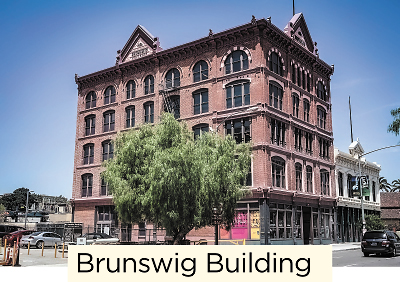 Over the years, we discussed many options for a permanent headquarters building for LACERS. The proposals included purchasing the Brunswig Building; purchasing various small buildings proximate to City Hall; integrating into what is now Blossom Plaza in Chinatown; building a structure east of the Chinatown “L” line (formerly the Gold line) or at Union Station; and purchasing part of the Los Angeles Times complex. The City also tried time and time again to have LACERS purchase Figueroa Plaza from the City. With Figueroa Plaza’s lack of proximity to City Hall and terrible parking situation, there was no way LACERS was going to purchase it! When none of those options came to fruition, LACERS had to decide what to do with its expiring lease at the Brunswig Building.
Over the years, we discussed many options for a permanent headquarters building for LACERS. The proposals included purchasing the Brunswig Building; purchasing various small buildings proximate to City Hall; integrating into what is now Blossom Plaza in Chinatown; building a structure east of the Chinatown “L” line (formerly the Gold line) or at Union Station; and purchasing part of the Los Angeles Times complex. The City also tried time and time again to have LACERS purchase Figueroa Plaza from the City. With Figueroa Plaza’s lack of proximity to City Hall and terrible parking situation, there was no way LACERS was going to purchase it! When none of those options came to fruition, LACERS had to decide what to do with its expiring lease at the Brunswig Building.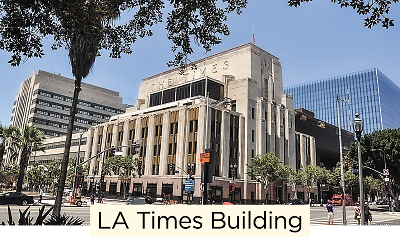 While negotiating a lease extension, LACERS became aware of space for lease at the Los Angeles Times complex. At first, LACERS just wanted to use the availability at the Times building as leverage to negotiate an extension to our existing lease, but the more LACERS looked at the Times building, the more it made sense to move there and take advantage of a below-market-rate lease we were being offered.
While negotiating a lease extension, LACERS became aware of space for lease at the Los Angeles Times complex. At first, LACERS just wanted to use the availability at the Times building as leverage to negotiate an extension to our existing lease, but the more LACERS looked at the Times building, the more it made sense to move there and take advantage of a below-market-rate lease we were being offered.